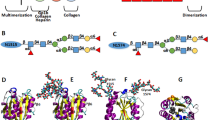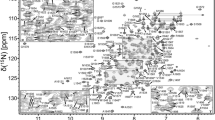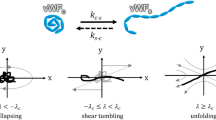Abstract
The A1 and A2 domains of von Willebrand factor (VWF) have important functions: A1 contains a binding site for platelet glycoprotein Ib (GPIb) while A2 contains a cryptic proteolytic site for the VWF-cleavage enzyme, A Disintegrin And Metalloprotease with a ThromboSpondin type 1 motifs 13 (ADAMTS-13). Because the proteolytic site is fully buried in the native A2 structure, A2 needs to be unfolded to expose its proteolytic site for ADAMTS-13 cleavage. To study the unfolding mechanism of the VWF A domains, we used molecular dynamics (MD) to simulate in atomic details the thermal unfolding of A1 and A2 at high temperatures. The thermal unfolding of A1 and A2 appears very different from their unfolding by tensile forces. At 500 K, unfolding of the central β sheet of A2 starts from the two edges and propagates into the center. β4 and β5 in the center are structurally the most stable and unfolded the latest. However, A2 could be unfolded along different pathways and the unfolded A2 structure is highly flexible. By comparison, A1 is unfolded slower than A2 at 500 K. In even longer time, the unfolding of A1 is limited to the edges of the central β sheet, suggesting a protective role of the N–C terminal disulfide bond.









Similar content being viewed by others
References
Auton, M., M. A. Cruz, and J. Moake. Conformational stability and domain unfolding of the Von Willebrand factor A domains. J. Mol. Biol. 366(3):986–1000, 2007.
Beck, D. A., and V. Daggett. Methods for molecular dynamics simulations of protein folding/unfolding in solution. Methods 34(1):112–120, 2004.
Case, D. A., T. A. Darden, T. E. Cheatham III, C. L. Simmerling, J. Wang, R. E. Duke, R. Luo, K. M. Merz, B. Wang, D. A. Pearlman, M. Crowley, S. Brozell, V. Tsui, H. Gohlke, J. Mongan, V. Hornak, G. Cui, P. Beroza, C. Schafmeister, J. W. Caldwell, W. S. Ross, and P. A. Kollman. AMBER 8. San Francisco: University of California, 2004.
Castaman, G., A. B. Federici, F. Rodeghiero, and P. M. Mannucci. Von Willebrand’s disease in the year 2003: towards the complete identification of gene defects for correct diagnosis and treatment. Haematologica 88(1):94–108, 2003.
Chen, W., J. Lou, and C. Zhu. Molecular dynamics simulated unfolding of von Willebrand factor A domains by force. Cell. Mol. Bioeng. 2(1):75–86, 2009.
Day, R., B. J. Bennion, S. Ham, and V. Daggett. Increasing temperature accelerates protein unfolding without changing the pathway of unfolding. J. Mol. Biol. 322(1):189–203, 2002.
Dent, J. A., S. D. Berkowitz, J. Ware, C. K. Kasper, and Z. M. Ruggeri. Identification of a cleavage site directing the immunochemical detection of molecular abnormalities in type IIA von Willebrand factor. Proc. Natl Acad. Sci. USA 87(16):6306–6310, 1990.
Dong, J. F., J. L. Moake, L. Nolasco, A. Bernardo, W. Arceneaux, C. N. Shrimpton, A. J. Schade, L. V. McIntire, K. Fujikawa, and J. A. Lopez. ADAMTS-13 rapidly cleaves newly secreted ultralarge von Willebrand factor multimers on the endothelial surface under flowing conditions. Blood 100(12):4033–4039, 2002.
Duan, Y., C. Wu, S. Chowdhury, M. C. Lee, G. Xiong, W. Zhang, R. Yang, P. Cieplak, R. Luo, T. Lee, J. Caldwell, J. Wang, and P. Kollman. A point-charge force field for molecular mechanics simulations of proteins based on condensed-phase quantum mechanical calculations. J. Comput. Chem. 24(16):1999–2012, 2003.
Emsley, J., M. Cruz, R. Handin, and R. Liddington. Crystal structure of the von Willebrand factor A1 domain and implications for the binding of platelet glycoprotein Ib. J. Biol. Chem. 273(17):10396–10401, 1998.
Franchini, M., and G. Lippi. Von Willebrand factor and thrombosis. Ann. Hematol. 85(7):415–423, 2006.
Furlan, M., R. Robles, and B. Lamie. Partial purification and characterization of a protease from human plasma cleaving von Willebrand factor to fragments produced by in vivo proteolysis. Blood 87(10):4223–4234, 1996.
Huizinga, E. G., S. Tsuji, R. A. Romijn, M. E. Schiphorst, P. G. de Groot, J. J. Sixma, and P. Gros. Structures of glycoprotein Ibalpha and its complex with von Willebrand factor A1 domain. Science 297(5584):1176–1179, 2002.
Humphrey, W., A. Dalke, and K. Schulten. VMD: visual molecular dynamics. J. Mol. Graph. 14(1):33–38, 27–28, 1996.
Levy, G. G., W. C. Nichols, E. C. Lian, T. Foroud, J. N. McClintick, B. M. McGee, A. Y. Yang, D. R. Siemieniak, K. R. Stark, R. Gruppo, R. Sarode, S. B. Shurin, V. Chandrasekaran, S. P. Stabler, H. Sabio, E. E. Bouhassira, J. D. Upshaw, Jr., D. Ginsburg, and H. M. Tsai. Mutations in a member of the ADAMTS gene family cause thrombotic thrombocytopenic purpura. Nature 413(6855):488–494, 2001.
Matsushita, T., and J. E. Sadler. Identification of amino acid residues essential for von Willebrand factor binding to platelet glycoprotein Ib. Charged-to-alanine scanning mutagenesis of the A1 domain of human von Willebrand factor. J. Biol. Chem. 270(22):13406–13414, 1995.
Mazzucato, M., P. Spessotto, A. Masotti, L. De Appollonia, M. R. Cozzi, A. Yoshioka, R. Perris, A. Colombatti, and L. De Marco. Identification of domains responsible for von Willebrand factor type VI collagen interaction mediating platelet adhesion under high flow. J. Biol. Chem. 274(5):3033–3041, 1999.
Michiels, J. J., A. Gadisseur, U. Budde, Z. Berneman, M. van der Planken, W. Schroyens, A. van de Velde, and H. van Vliet. Characterization, classification, and treatment of von Willebrand diseases: a critical appraisal of the literature and personal experiences. Semin. Thromb. Hemost. 31(5):577–601, 2005.
Padilla, A., J. L. Moake, A. Bernardo, C. Ball, Y. Wang, M. Arya, L. Nolasco, N. Turner, M. C. Berndt, B. Anvari, J. A. Lopez, and J. F. Dong. P-selectin anchors newly released ultralarge von Willebrand factor multimers to the endothelial cell surface. Blood 103(6):2150–2156, 2004.
Phillips, J. C., R. Braun, W. Wang, J. Gumbart, E. Tajkhorshid, E. Villa, C. Chipot, R. D. Skeel, L. Kale, and K. Schulten. Scalable molecular dynamics with NAMD. J. Comput. Chem. 26(16):1781–1802, 2005.
Romijn, R. A., B. Bouma, W. Wuyster, P. Gros, J. Kroon, J. J. Sixma, and E. G. Huizinga. Identification of the collagen-binding site of the von Willebrand factor A3-domain. J. Biol. Chem. 276(13):9985–9991, 2001.
Sadler, J. E. Biochemistry and genetics of von Willebrand factor. Annu. Rev. Biochem. 67:395–424, 1998.
Sadler, J. E. von Willebrand factor: two sides of a coin. J. Thromb. Haemost. 3(8):1702–1709, 2005.
Sutherland, J. J., L. A. O’Brien, D. Lillicrap, and D. F. Weaver. Molecular modeling of the von Willebrand factor A2 Domain and the effects of associated type 2A von Willebrand disease mutations. J. Mol. Model. 10(4):259–270, 2004.
Tsai, H. M. Physiologic cleavage of von Willebrand factor by a plasma protease is dependent on its conformation and requires calcium ion. Blood 87(10):4235–4244, 1996.
Tsai, H. M. Deficiency of ADAMTS13 and thrombotic thrombocytopenic purpura. Blood 100(10):3839–3840, 2002 (author reply 3840–2).
Tsai, H. M., I. I. Sussman, and R.L. Nagel. Shear stress enhances the proteolysis of von Willebrand factor in normal plasma. Blood 83(8):2171–2179, 1994.
Walser, R., A. E. Mark, and W. F. van Gunsteren. On the temperature and pressure dependence of a range of properties of a type of water model commonly used in high-temperature protein unfolding simulations. Biophys. J. 78(6):2752–2760, 2000.
Wu, T., J. Lin, M. A. Cruz, J. F. Dong, and C. Zhu. Force-induced cleavage of single VWFA1A2A3 tridomains by ADAMTS-13. Blood 115(2):370–378, 2010.
Zhang, Q., Y. F. Zhou, C. Z. Zhang, X. Zhang, C. Lu, and T. A. Springer. Structural specializations of A2, a force-sensing domain in the ultralarge vascular protein von Willebrand factor. Proc. Natl Acad. Sci. USA 106(23):9226–9231, 2009.
Acknowledgments
We thank Dr. Stephen Harvey for providing computational resources for the MD simulations. We also acknowledge NSF TeraGrid for providing supercomputer time via NCSA DAC grant MCB080011N and LRAC grant MCA08X014. This work is supported by NIH grants HL093723 and HL091020.
Author information
Authors and Affiliations
Corresponding author
Additional information
Associate Editor Edward Guo oversaw the review of this article.
Electronic supplementary material
Below is the link to the electronic supplementary material.
Figure S1
Comparison between the A2 crystal structure and the A2 homology model. (a) Structural alignment of the A2 homology model (yellow) to the A2 crystal structure (red). The biggest difference in the α4–β4 region is indicated. (b) RMSD of Cα atoms of residue 1496–1669 between the two A2 structures. The largest RMSD in the α4–β4 region is indicated (TIFF 407 kb)
Figure S2
SASAs of the A2 proteolytic site (Tyr1605 and Met1606) during the A2 equilibration at 300 K. Results of both backbones (black curve) and sidechains (gray curve) are shown for simulations with the A2 crystal structure (a) and the A2 homology model (b) (TIFF 421 kb)
Video 1
Thermal unfolding of the A2 crystal structure in the NVE ensemble at 500 K. A2 is oriented with β strands β3, β2, β1, β4, β5, and β6 from the left to the right. A2 structures are colored according secondary structures: α helix in purple, 310 helix in blue, π helix in red, β sheet in yellow, β bridge in orange, turn in cyan, and loop in white. The blue and the red spheres indicate the N- and C-terminal Cα atoms, respectively. The backbone atoms of Tyr1605 and Met1606 adjacent to the proteolytic site are shown as green spheres (AVI 27486 kb)
Video 2
Thermal unfolding of the A2 homology model in the NVE ensemble at 500 K. Representations of A2 structures are the same as Video 1 (AVI 25632 kb)
Video 3
Thermal unfolding of the A2 homology model in the NPT ensemble at 500 K. Representations of A2 structures are the same as Video 1 (AVI 29154 kb)
Video 4
Thermal unfolding of A1 in the NVE ensemble at 500 K. A1 is oriented with β strands β6, β5, β4, β1, β2, and β3 from the left to the right. A1 structures are colored according secondary structures: α helix in purple, 310 helix in blue, π helix in red, β sheet in yellow, β bridge in orange, turn in cyan, and loop in white. The blue and the red spheres indicate the N- and C-terminal Cα atoms, respectively. The N–C terminal disulfide bond is shown as green sticks (AVI 28868 kb)
Video 5
Thermal unfolding of A1 in the NPT ensemble at 500 K. Representations of A1 structures are the same as Video 4 (AVI 13656 kb)
Rights and permissions
About this article
Cite this article
Chen, W., Lou, J. & Zhu, C. Simulated Thermal Unfolding of the von Willebrand Factor A Domains. Cel. Mol. Bioeng. 3, 117–127 (2010). https://doi.org/10.1007/s12195-010-0117-z
Received:
Accepted:
Published:
Issue Date:
DOI: https://doi.org/10.1007/s12195-010-0117-z




